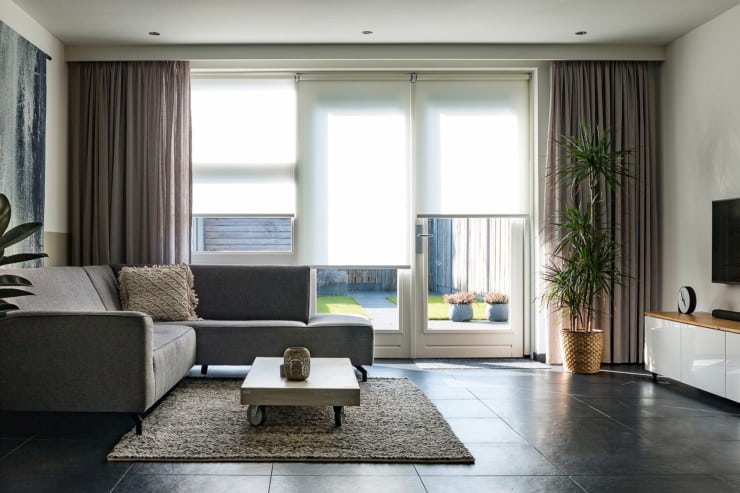9 Ways To Reduce Echo in a Room With High Ceilings
The scientific term for echo is reverberation. The effect of echo can be sensed in a tall staircase or a lengthy tunnel.
Likewise, the rooms with high ceilings also produce a considerable echo.
Even though the rooms with high ceilings are tempting because of their space, they can produce a severe echo.
The presence of a significant space promotes the bouncing of the sound waves. Hearing music, TV, or having a conversation in this room could be a challenge.
How to reduce echo in a room with high ceilings?

A room with high ceilings has loads of parallel hard surfaces.
Sound bounces off these surfaces without losing much energy. You have to shout so that other people can hear you, but the echo keeps lingering.
However, you can curb these distracting sounds with a bit of thought and mindful implementation of a few strategies.
Check out the nine best methods to reduce echo in the room with high ceilings:
1. Install acoustic panels to enhance sound absorption
The conventional acoustic panel could be highly effective at reducing sound from reflecting back and forth.
IZO All Supply and Dekiru Hexagon Acoustic Panels are currently very popular when it comes to selecting acoustic panels.
Each product aims to help with sound absorption and reduce sound vibrations.
There is a wide array of colors and designs available for acoustic panels. From wedgy to flat and much more, you can find the ones that fit your wall and ceiling well.
Acoustic panels like these look awesome!
Their high-density polyurethane material is environmentally friendly. It accentuates useless sound waves in theaters, offices, and concert halls.
Industry experts vouch for the efficiency of acoustic control.
The foam panels help eliminate echos because they contain fine voids and semi-open holes. These will absorb normal, high, and even low sound frequencies.
In fact, the panels can also improve the sound quality of your rooms. They have a wedge surface of 12 grooves that expands the contact area with the sound waves.
Consequently, the absorption effect gets better than other shapes of the surface.
2. Soften solid surfaces with rugs and curtains
Another thing you can do to reduce sound in a high-ceiling room is to reduce the hardness of its surfaces.
Rugs on a hardwood floor will make the room less reverberant.
Not to mention, these will add color and life to the otherwise dull room. You can opt for solid colors, mature patterns, or you can mix and match!
Curtains are another essential component to reduce echo in a room.
Bear in mind; the larger and heavier the curtains are, the more effective they become at sound absorption.
In fact, some blackout curtain sellers use their sound absorption as a selling point.
Their ability to reduce external noises performs an additional task of absorbing sounds within the room.
Curtains and rugs offer a low-cost alternative to pricey soundproof solutions. If you are looking for a quick and easy solution, these items are your best bet.
3. Use acoustic ceiling tiles
Another method of halting the sound from moving around your room is to install acoustic ceiling tiles.
These are helpful in a home theater and game rooms where noise is a significant concern.
Using the acoustic ceiling tiles makes the room resistant to sound transmission. Apart from this, it also makes it better to shut the sound off.
Many people have the assumption that using a good quality sound system will solve your acoustic dilemmas. This isn’t true.
It would help if you choose a sustainable solution like installing acoustic ceiling tiles. The tiles decrease the amplification of sounds.
It is turning into the best method of enhancing the room décor. The ceiling covers your pipeline work and electrical attachments, making this room catchy and pleasant.
4. Fill the room with furniture

Even a tiny empty room makes the sound bounce from wall to wall. There is no protection to block the sound waves.
But when it comes to the room with high ceilings, keeping it empty could be a big mistake. Instead, consider filing such spaces with plenty of furniture.
You can use:
- A closet filled with clothes
- A sofa
- A bookshelf filled with books
- A vase with large plants
- Collectibles and plush toys
Apart from these options, you can find furniture items of your liking.
Make sure that there are more noise-dampening materials in the room. You could try being practical and creative when filling the room with such items.
5. Cover the walls with 3D wallpaper
Wallpaper is the classic and good-looking option for most home and work settings. You can cover the walls with acoustic tiles to reduce echo in the room.
Nonetheless, this isn’t suitable for all kinds of rooms.
Although a thick wallpaper can do the job, it is essential to use a type that isn’t entirely flat. 3D wallpaper designs are great at absorbing sounds because of their little nooks and crevices.
You can find some fantastic designs of 3D wallpapers online and in stores.
On top of everything, installing these wallpapers is relatively easy. It is self-adhesive, so no tools are required to paste it on the wall.
6. Hang wall and textile art on parallel walls
A cloth art or a life-sized canvas painting adds an absorption surface to the room.
It blocks the ability of sound to travel back and forth between adjacent walls. Placing soft items on parallel surfaces will combat the echo.
It is essential to acknowledge some key elements before you choose wall art.
For instance, heavy oil paint resembles a hard surface when dry. This will cause reflection and diffusion of the sound waves.
Hence, make sure you find softer wall art. You may even consider hanging a colorful rug or a blanket instead of a painting.
These solutions are easy-to-install and cheap on the pockets.
7. Insulation by FiberGlass
Another practical choice that will help to reduce echo in a high-ceiling room is fiberglass insulation. You can install it on the walls, floors, and ceilings.
This type of insulation reduces echo in the same room. Not only this, but it also blocks noises from room to room and between different levels of the house.
Installing soundproof insulation carries plenty of benefits for people living in a crowded area.
The sound of heavy traffic and hustle-bustle in the community creates substantial noise.
Moreover, the fiberglass makes a room thermal proof too.
This makes it a profitable investment because energy efficiency spikes. It also shortens hefty loads for heating and cooling the house.
8. Add plants in the room

Using plants to block the noise is one of the most natural solutions to your misery. Plants will uplift the aesthetic beauty, making it a fresh space to be in.
Of course, any leafy greens will do the task. But, we strongly recommend you opt for plants with larger leaves as they are more effective than the small ones.
You can enhance the pleasant environment of a high-ceiling room by placing plants all around. The more plants you add, the merrier.
If you want to reduce the low-frequency echo, try moving the most prominent plants to the corner of a room. Low-frequency noises usually gather at the corners.
9. Install mass-loaded vinyl
Installing mass-loaded vinyl is the most expensive yet highly effective way to deal with noise.
MLV is a flexible membrane attached to walls. It drastically absorbs and blocks the sound waves.
The vinyl covers your existing drywall. Next, a new layer of drywall is added on top of MLV.
The material is heavyweight but non-toxic and odor-free. If you are handy with plenty of experience with home improvement, you can complete this task with assistance.
When doing so, make sure that you use acoustic calk along seams and cracks to cover every square inch of the walls.
This is an effective method for eliminating echos. It is flexible, reasonable, and helps for different purposes.
You can use it in home theaters, studio programs, or simply around the house.
FAQs
Are high ceilings good for acoustics?
High ceilings increase volume in a room.
They also create a high reverberation time as sound waves have to travel a long distance before a hard surface gets to reflect them.
These qualities mean that high ceilings are bad for acoustics.
How do you soundproof ceilings and walls?
An effective way to soundproof ceilings and walls is to add a batt or blanket insulation between joists and studs.
This will absorb the sound that could easily travel between air pockets in the wall framing.
Final Thoughts
By now, you must know that it isn’t a daunting task to reduce echo in a high-ceiling room.
You need to analyze the space and learn how to reduce echo in a room with high ceilings. Even on a relatively minor budget, you can find plenty of ways to improve the acoustics of your room.
Don’t hesitate to reach out to a professional service for recommendations if you aren’t sure of your approach.







